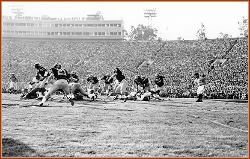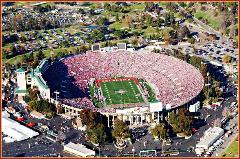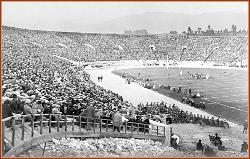



Aggie Memorial Stadium is a stadium in Las Cruces, New Mexico. It is primarily used for American football, and is the home field of the New
Mexico State University Aggies. It opened in 1978 and holds 30,343 people.
Prior to the construction of the stadium the Aggies had played on the same site since 1933. Located just to the northeast of Hadley Hall (the
university's Administration building), and originally known as Quesenberry Field, the original Memorial Stadium was built over it in 1950. It was
dedicated as a memorial to New Mexico A&M students who had died in World War II, World War I, and the Spanish-American War, among whom
was Henry C. Gilbert Jr., whose parents were instrumental in the 10-year long fundraising drive. Memorial Stadium, which served for twenty-eight
seasons, was replaced both due to its small size (at maximum, the seating capacity was only 12,155) and the want of an expanded athletics plant
with more infrastructure and parking. (Currently Memorial Tower, which was originally part of the press box of the stadium, is the only remaining
reminder of the stadium. It is now structurally incorporated into the university's Health and Social Services building and houses a memorial
lounge and computer lab.)
The "new" Aggie Memorial Stadium, this time dedicated to alumni who had served in the Korean War and Vietnam War, was built for $4 million
over a period of eighteen months. It was funded by the state legislature as part of a capital project on the campus. The first home game saw the
Aggies defeat rival UTEP 35-32 on September 16, 1978. Twenty years and ten days later, the Aggies and Miners played to the largest crowd in
stadium history, with 32,993 in attendance to see the Aggies win again, 33-24. The stadium, designed by alumnus Craig Protz of Bohering-Protz
Associates, was built just to the south of the Pan American Center, the home of Aggie basketball. The stadium boasts a unique design in which
earth that was excavated to construct the lower bowl and field level was moved to the sides of the stadium to support the upper level, with a
street level concourse dividing the lower and upper bowls. The first level of seating wraps around the field, except for two 100-foot wide gaps
behind each end zone. The southern end is a grass berm, with the Fulton Athletics Center, a $6 million structure constructed in 2004 housing
athletics offices, an athletic training and education center, and club facilities, behind it. The northern end leads to the locker room facilities and
main entrance to the stadium. Because of these gaps it was previously impossible to access the east side of the stadium from the west, and vice
versa, without exiting the stadium and re-entering on the other side. A bridge over the north ramp constructed prior to the 2006 season now
allows fans to cross from one side of the stadium to the other. The seating extends to a rounded second level on either side of the field, which
extends the length of the playing field. The curved, undulating design of the upper level is reminiscent of similarly designed structures such as
Memphis' Liberty Bowl Stadium and the now-demolished Tampa Stadium, albeit on a somewhat smaller scale. The stadium also is known for
being well-lit for night games, with the original four pole sodium vapor lighting system now being augmented by four additional smaller poles
added prior to the 2005 season to increase the stadium's lighting capacity for televised night games. For the 2007 season, a new $1.5 million
scoreboard including a 38'x23' video screen has been added to the facility, as well as a new team meeting and video room complex adjacent to
the field house on the stadium's north end.
In addition to football, the stadium occasionally hosts major concerts and other large outdoor gatherings on campus. Among the major acts which
have played stadium concerts at Aggie Memorial are Guns N' Roses, Metallica, The Eagles, and Paul McCartney. During the 2005-06 renovation
of the nearby Pan American Center, the stadium hosted the university's commencement ceremonies, although they returned to the Pan Am
following completion of the renovations.






